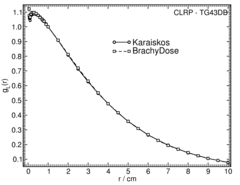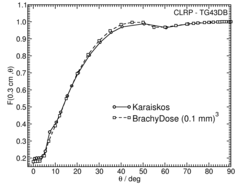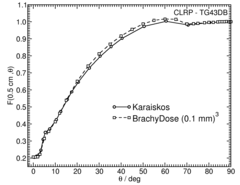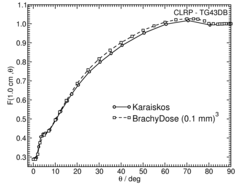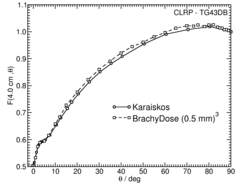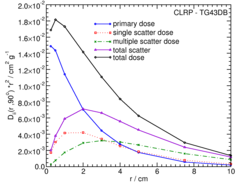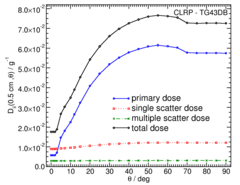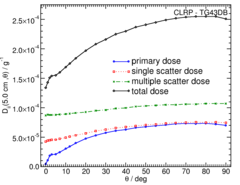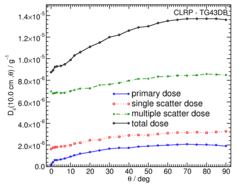

Source Description:
The SelectSeed source 1,2,3 dimensions are taken from the study by Karaiskos et al . The source element for the SelectSeed is a cylindrical silver rod with an outer diameter of 0.510 mm and a length of 3.40 mm. The rod is coated with a silver halide layer (AgCl/AgI) that is 3.00 μm thick. The titanium encapsulation has a 0.800 mm outer diameter and is 0.050 mm thick. End welds are 0.400 mm thick and hemispherical in shape. The overall length is 4.50 mm and the active length of the source is 3.40 mm. The cylindrical source element is free to move approximately 0.147 mm along the seed axis and 0.092 mm radially from the center of the seed.Dose Rate Constant - Λ :
Dose rate constants, Λ , are calculated by dividing the dose to water per history in a (0.1 mm) 3 voxel centered on the reference position, (1 cm,Π/2), in the 30x30x30 cm 3 water phantom, by the air kerma strength per history (scored in vacuo ). As described in ref. 4 , dose rate constants are provided for air kerma strenth calculated using voxels of 2.7x2.7x0.05 cm 3 (WAFAC) and 0.1x0.1x0.05 cm 3 (point) located 10 cm from the source. The larger voxel size averages the air kerma per history over a region covering roughly the same solid angle subtended by the primary collimator of the WAFAC 5,6 at NIST used for calibrating low-energy brachytherapy sources and is likely the most clinically relevant value. The small voxel serves to estimate the air kerma per history at a point on the transverse axis.
| Author | Method | Λ (cGy h-1 U-1) | Abs. Uncertainty |
| R. E. P. Taylor, D. W. O. Rogers 7 | WAFAC | 0.917 | 0.002 |
| R. E. P. Taylor, D. W. O. Rogers 7 | point | 0.944 | 0.003 |
| Karaiskos et al 1 | MC | 0.954 | 0.005 |
| G. Anagnostopoulos et al 2 | TLD | 0.938 | 0.065 |
| P. Papagiannis et al 3 | TLD | 0.987 | 0.077 |
Radial dose function - g(r):
The radial dose function, g(r), is calculated using both line and point source geometry functions and tabulated at 36 different radial distances ranging from 0.05 cm to 10 cm. Fit parameters for a modified polynomial expression are also provided 8 .
| Fitting coefficients for g L (r) = (a 0 r -2 + a 1 r -1 +a 2 + a 3 r +a 4 r 2 + a 5 r 3 ) e -a 6 r | ||||||||
| Fit range | Coefficients | |||||||
| r min (cm) | r max (cm) | a 0 / cm 2 | a 1 / cm | a 2 | a 3 / cm -1 | a 4 / cm -2 | a 5 / cm -3 | a 6 / cm -1 |
| 0.05 | 10.00 | 5.9991E-04 | -1.4694E-02 | 1.1588E+00 | 4.5675E-01 | -3.8617E-03 | 3.2066E-03 | 4.7050E-01 |
Anisotropy function - F(r,θ):
Anisotropy functions are calculated using the line source approximation and tabulated at radii of 0.1, 0.15, 0.25, 0.5, 0.75, 1, 2, 3, 4, 5, 7.5 and 10 cm and 32 unique polar angles with a minimum resolution of 5 o . The anisotropy factor, φ an (r), was calculated by integrating the solid angle weighted dose rate over 0 o ≤ ϑ ≤ 90 o .
Primary and Scatter Separated (PSS) Dose Data: D ii (r,θ):
Primary and Scatter Separated (PSS) dose data are tabulated at 12 radii from 0.25 cm to 20 cm and 47 unique polar angles with a minimum resolution of 5 o . High resolution (Δr = 1 mm, ΔΘ = 1 o ) primary scatter dose data are also available in .csv files. For the purposes of these calculations, scatter within the source is not considered and any photon escaping the source encapsulation is considered a primary. Only photons which scatter within the phantom are counted in the scatter tallies. Doses are normalized to the total photon energy escaping the encapsulation.
High resolution (1mm/1 o ) Tabulated D ii (r,θ) data in .csv format: Primary , Single Scat , Multiple Scat , Total
Energy Weighted Photon Spectrum, (dR/dE)/R
The energy weighted photon spectra are scored as:
(dR(E j )/dE)/R = ∑ E i / (ΔE . R)where E j is the energy of the middle of a bin, E i is the energy of the i th photon escaping the encapsulation or cable with energies between E j ± ΔE/2 and ΔE is the bin width. Energy weighted photon spectra are normalized to the total radiant photon energy, R (total energy of photons escaping the encapsulation/cable) yielding uints of MeV -1 . The spectrum data is available in csv format below. The first line in the csv files contains the number of bins in the file (N), followed by the bin width of all the bins. The next N lines contain the energy of the center of the bin (E j ) followed by the value of (dR(E j )/dE)/R.
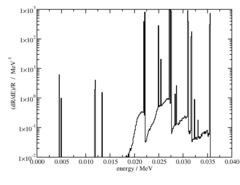
Energy weighted photon spectrum data: csv
References:
1. Karaiskos et al , Monte Carlo dosimetry of the selectSeed 125 I interstitial brachytherapy seed, Med. Phys., 28 , 1753--1760, 2001
2. G. Anagnostopoulos et al , Thermoluminescent dosimetry of the selectSeed 125 I interstitial brachytherapy seed, Med. Phys., 29 , 709--716, 2002
3. P. Papagiannis et al , On the dose rate constant of the selectSeed 125 I interstitial brachytherapy seed, Med. Phys., 33 , 1522--1523, 2006
4. R. E. P. Taylor et al , Benchmarking BrachyDose: voxel-based EGSnrc Monte Carlo calculations of TG--43 dosimetry parameters, Med. Phys., 34 , 445 -- 457, 2007
5. R. Loevinger, Wide-angle free-air chamber for calibration of low--energy brachytherapy sources, Med. Phys., 20 , 907, 1993
6. S. M Seltzer et al , New National Air-Kerma-Strength Standards for 125 I and 103 Pd Brachytherapy Seeds, J. Res. Natl. Inst. Stand. Technol., 108 , 337 -- 358, 2003
7. R. E. P. Taylor, D. W. O. Rogers, An EGSnrc Monte Carlo-calculated database of TG-43 parameters, Med. Phys., 35 , 4228--4241, 2008
8. R. E. P. Taylor, D. W. O. Rogers, More accurate fitting of 125 I and 103 Pd radial dose functions, Med. Phys., 35 , 4242--4250, 2008
Carleton Laboratory for Radiotherapy Physics
August 29 2008.
